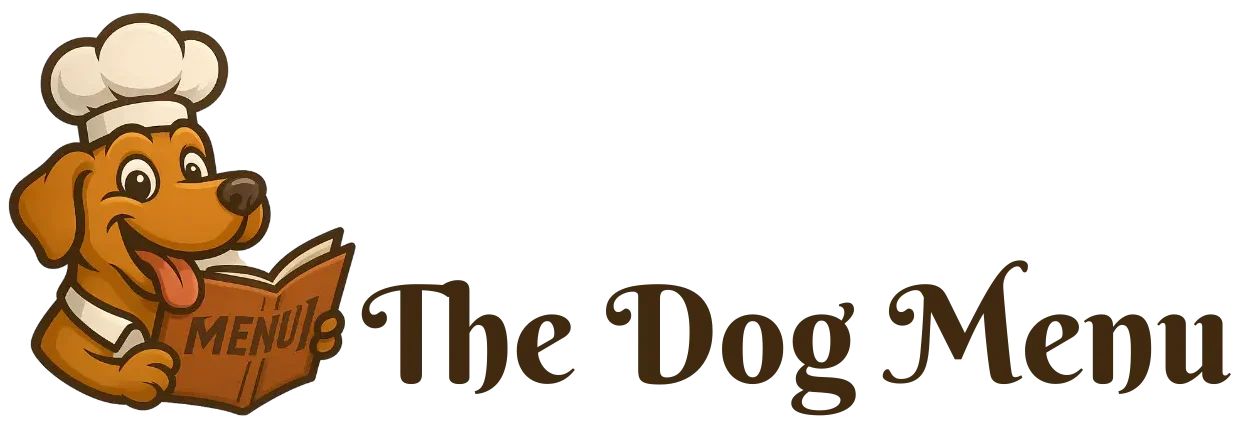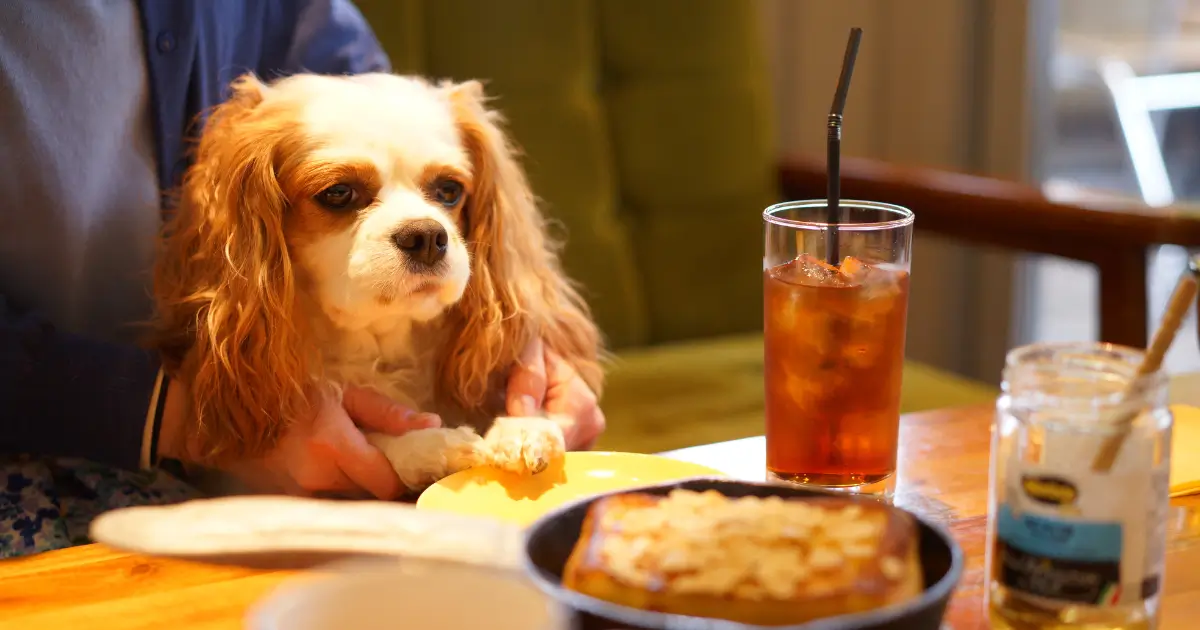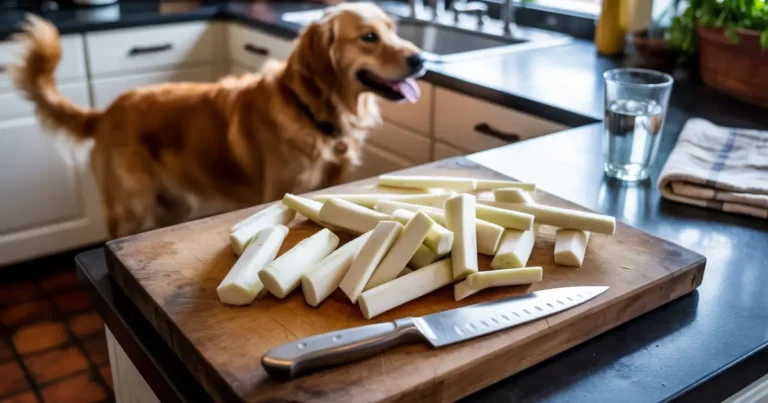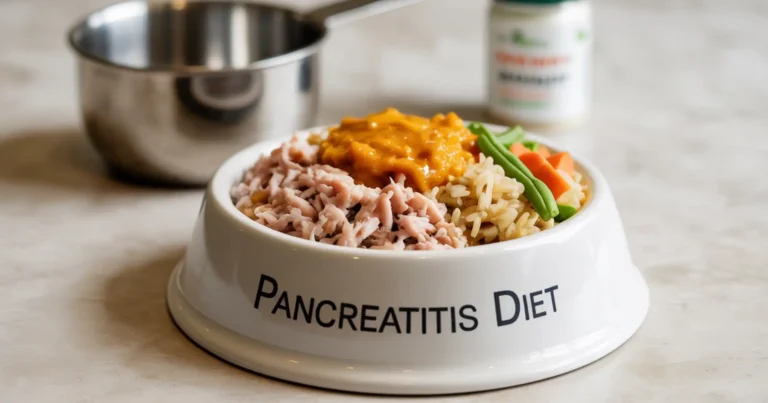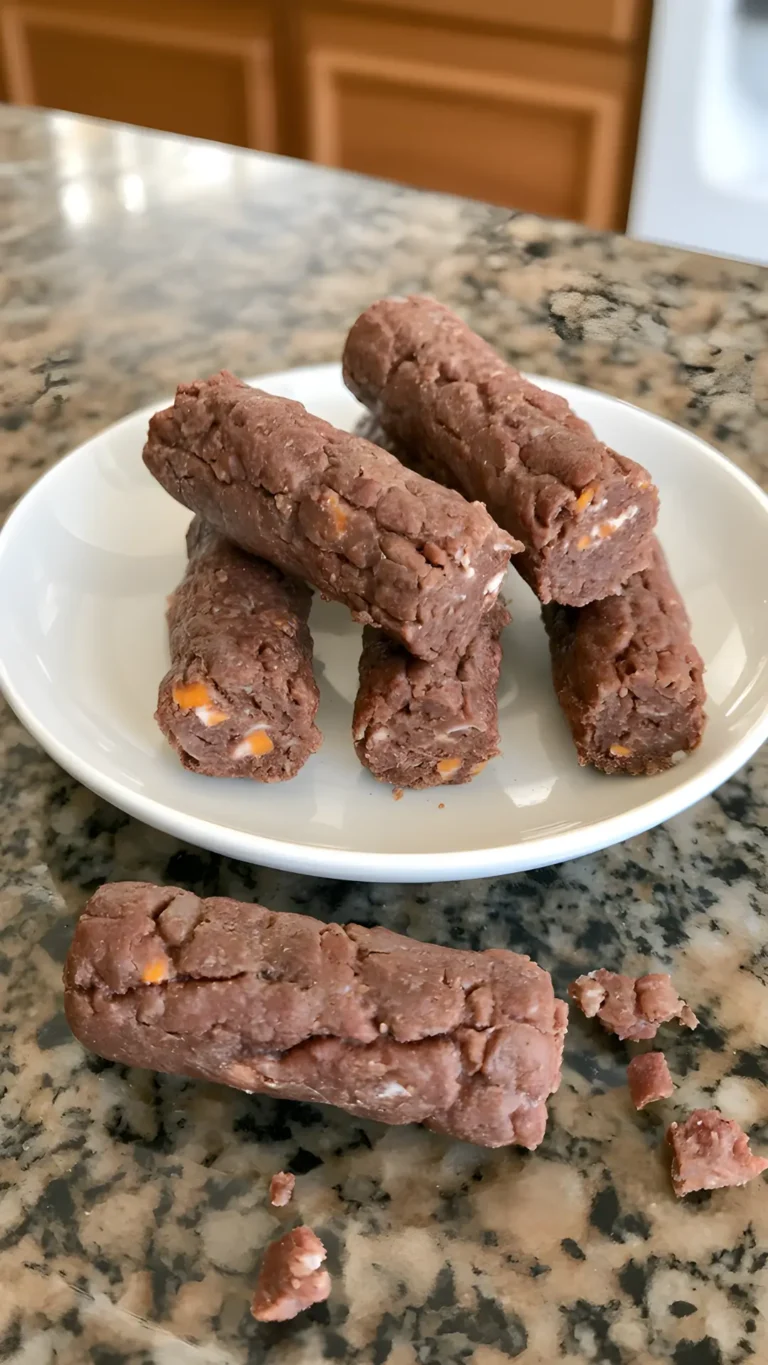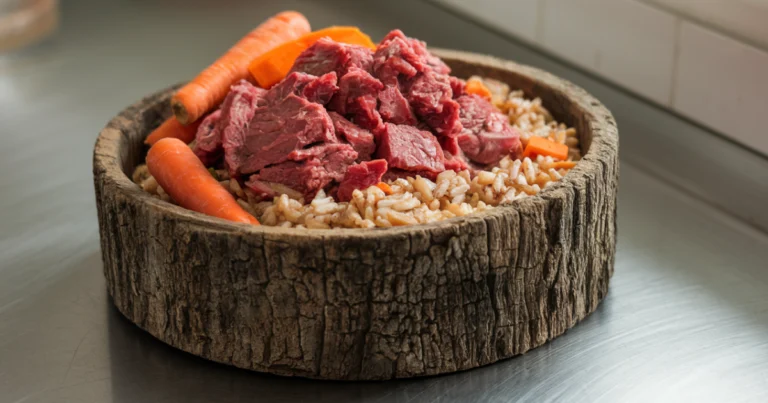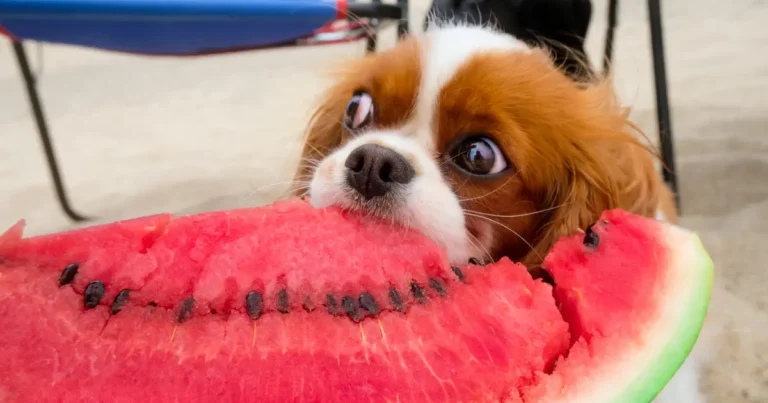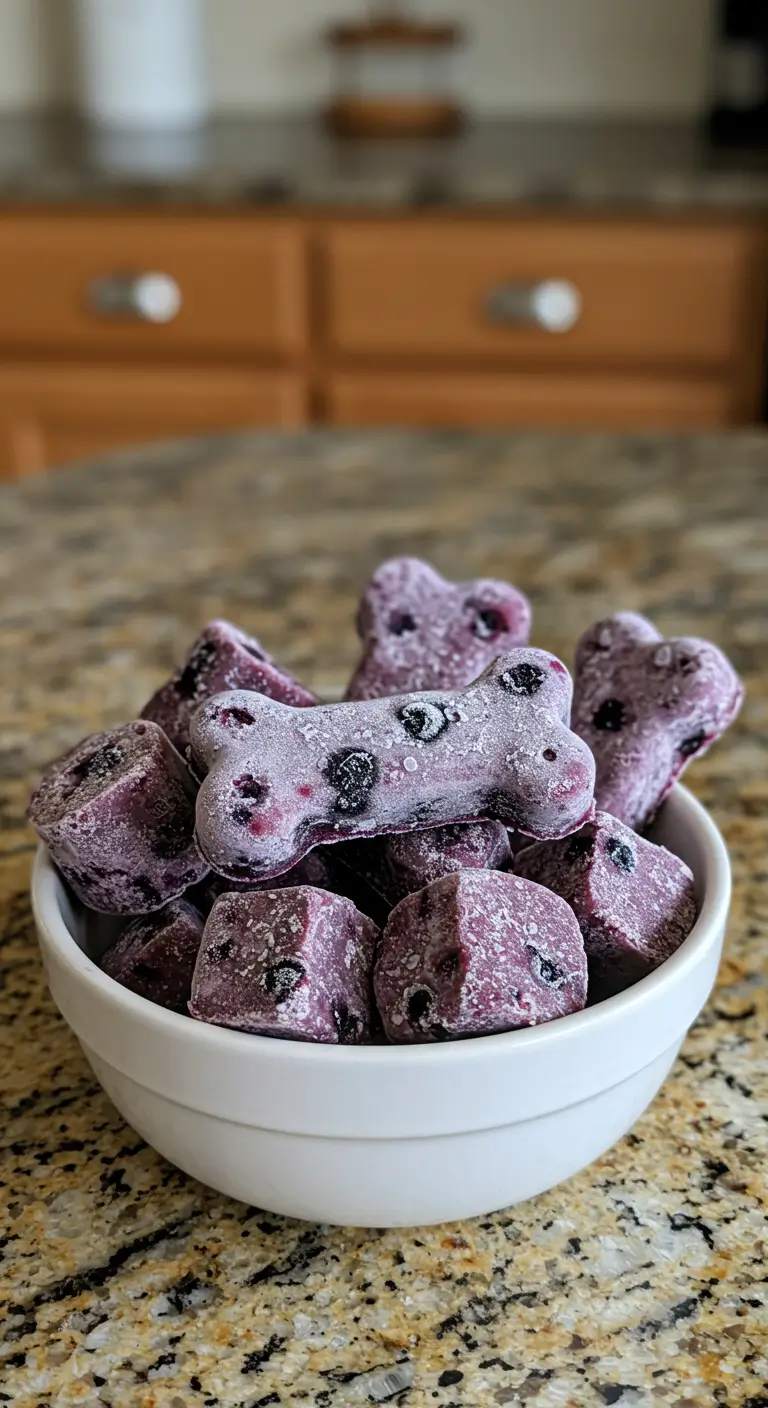What Foods Can Dogs Eat From The Table: 12 Safe Tips
As a dog owner, you’ve likely experienced those pleading eyes staring up at you while you enjoy your meal. The temptation to share your food with your canine companion can be strong, but what foods can dogs eat from the table safely? This question isn’t just about indulging your pet; it’s about understanding what human foods are safe, beneficial, or potentially harmful for your dog.
Dogs should not be fed table scraps, according to conventional wisdom, but the truth is more complex. Some human foods can be safely shared in moderation, while others pose serious health risks. Understanding the difference is crucial for maintaining your dog’s health and well-being.
In this comprehensive guide, we’ll explore the safe foods you can share from your table, those to avoid entirely, and provide you with 12 essential tips for safely incorporating human food into your dog’s diet. We’ll also briefly touch on specific foods like popcorn, pickles, marshmallows, pretzels, Jello, and granola, which we’ll explore in greater depth in separate guides.
Table of Contents
Understanding Your Dog’s Digestive System
Before we discuss what foods can dogs eat from the table, it’s important to understand why your dog’s dietary needs differ from your own. Dogs have evolved as omnivores with digestive systems that process foods differently from humans.
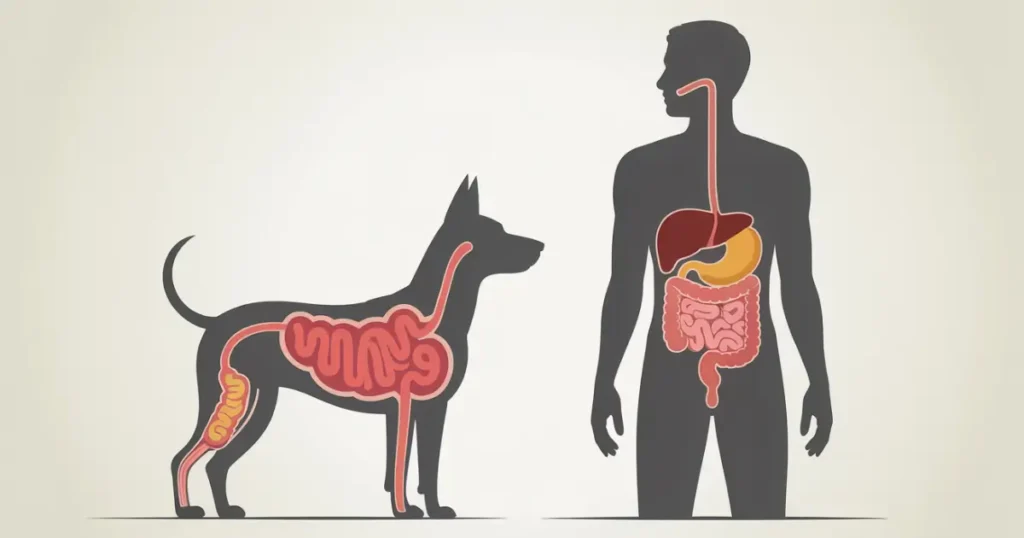
Canine vs. Human Digestion
Dogs have:
- Shorter digestive tracts are designed to process food quickly
- Higher stomach acidity to handle bacteria in meat
- Different enzymatic systems that process certain foods differently
- Limited ability to digest complex carbohydrates
- No dietary requirement for many foods humans consume regularly
These differences explain why some foods that are perfectly safe for humans can cause serious health issues in dogs. It also explains some of the dangers of feeding dogs table scraps indiscriminately.
The Myth of “Dogs Ate Table Scraps for Thousands of Years”
While it’s true that dogs historically consumed human food leftovers, modern table food often bears little resemblance to the simpler diet of our ancestors. Today’s human foods frequently contain:
- Higher fat content
- More preservatives
- Added sugars
- Artificial sweeteners
- Various seasonings and spices
- Complex blends of ingredients
This complexity is one reason why veterinarians often caution against the regular feeding of table scraps to dogs. Modern processed foods may contain ingredients that weren’t part of historical human-canine food-sharing relationships.
Tip 1: Understand the Definite “No” Foods
When considering what foods can dogs eat from the table, it’s crucial to first establish which foods should never be shared with your dog under any circumstances. These foods can cause serious health problems or even be fatal to your pet.
Absolutely Toxic Foods for Dogs
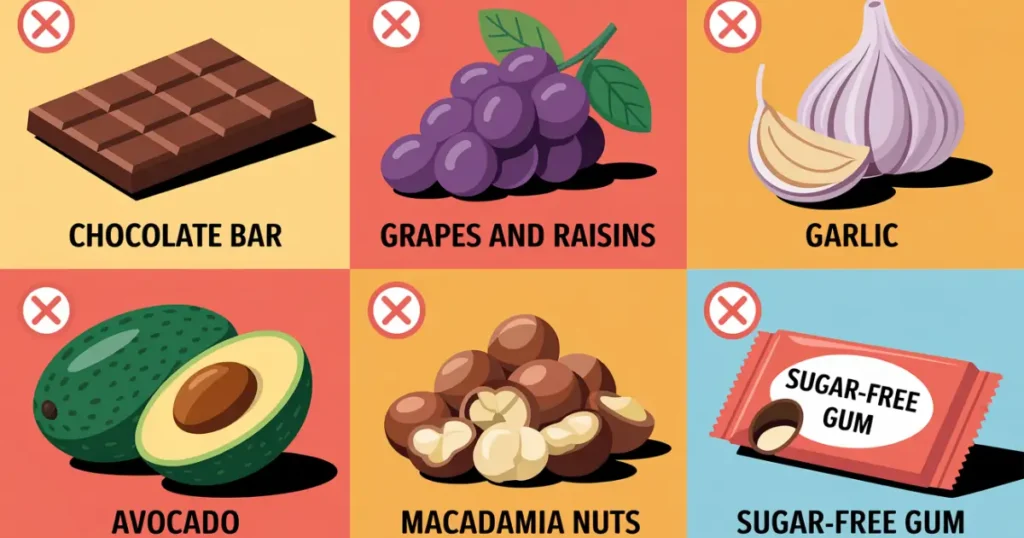
These foods should never be given to dogs:
- Chocolate – contains theobromine, which is difficult for dogs to properly metabolize.
- Grapes and raisins – Even in trace amounts, grapes and raisins can result in renal failure.
- Onions, garlic, and chives – Damage red blood cells and can cause anemia
- Avocados – Contain persin, which can cause vomiting and diarrhea
- Alcohol – Even small amounts can cause serious health problems
- Xylitol (artificial sweetener) – Can cause insulin release, leading to liver failure
- Macadamia nuts – Can cause weakness, hyperthermia, and vomiting
- Caffeine and coffee – are stimulants that can harm the nervous system and cause heart problems.
- Raw yeast dough – Can expand in the stomach and release alcohol through fermentation
Understanding these absolute prohibitions is the first step in safely sharing food with your dog. Later, we’ll discuss foods that fall into gray areas that may be acceptable in moderation.
Tip 2: Prioritize Lean Proteins
When considering what foods can dogs eat from the table safely, lean proteins typically top the list. Protein is an essential component of your dog’s diet, and certain human-grade proteins can be beneficial additions when prepared properly.
Safe Protein Options

These protein sources can generally be shared with your dog in moderation:
- Chicken (plain, cooked, no bones) – Excellent source of lean protein
- Turkey (plain, cooked, no bones) – Similar to chicken, but avoid fatty skin
- Lean beef (cooked, no seasonings) – Good source of protein and iron
- Fish (fully cooked, no bones) – Provides protein and omega-3 fatty acids
- Eggs (cooked) – Great protein source with essential amino acids
Preparation Matters
The way you prepare proteins significantly impacts their safety for your dog:
- Remove all bones – Cooked bones can splinter and cause choking or intestinal damage
- Avoid seasonings – Skip the salt, spices, garlic, and onions
- Cook thoroughly – Avoid raw or undercooked meat due to bacterial risks
- Trim excess fat – High-fat content can lead to pancreatitis
- Serve in moderation – Even healthy proteins should be occasional treats
When properly prepared, these protein sources can be some of the safest table scraps for dogs to consume occasionally.
Tip 3: Introduce Vegetables Strategically
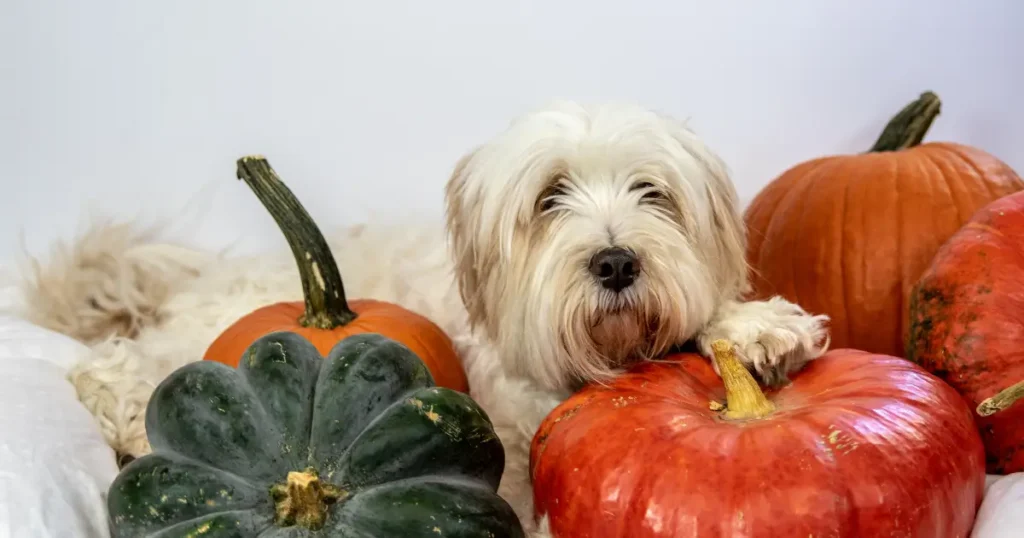
Many vegetables can be excellent additions to your dog’s diet when you’re considering what foods can dogs eat from the table. Vegetables provide valuable nutrients, fiber, and can even help clean teeth.
Dog-Friendly Vegetables
These vegetables are generally safe for most healthy dogs:
- Carrots – Rich in fiber and vitamin A, good for dental health when raw
- Green beans – Low-calorie, high-fiber option that many dogs enjoy
- Pumpkin (plain, cooked) – Excellent for digestive health
- Sweet potatoes (cooked, plain) – High in beneficial nutrients
- Cucumber – High water content makes it hydrating and low in calories
- Broccoli (in small amounts) – Contains valuable nutrients, but can cause gas
- Zucchini – Mild-flavored and nutrient-rich
Vegetables to Avoid
Not all vegetables are safe for canine consumption:
- Onions and garlic – Toxic to dogs, can cause anemia
- Mushrooms – Some varieties can be toxic
- Rhubarb – Contains oxalates that can cause kidney problems
- Unripe tomatoes – The green parts contain solanine, which is toxic
Serving Suggestions
Vegetables are easier for your dog to digest and more pleasurable when prepared properly:
- Cook starchy vegetables like potatoes and sweet potatoes
- Serve in bite-sized pieces to prevent choking
- Avoid butter, oil, salt, and seasonings
- Start with tiny doses to make sure your dog can handle them.
Vegetables can be among the healthiest table scraps for dogs when chosen carefully and prepared properly.
Tip 4: Be Cautious with Fruits
Fruits can be delicious treats for dogs, but they require careful selection and preparation. When considering what foods can dogs eat from the table, fruits should be approached with more caution than vegetables.
Dog-Safe Fruits
These fruits are generally safe for most dogs in moderation:
- Apples (no seeds or core) – Contain vitamins A and C
- Bananas – Rich in potassium but high in sugar
- Blueberries – Antioxidant-rich superfood
- Strawberries – Contain fiber and vitamin C
- Watermelon (no seeds or rind) – Hydrating, low-calorie treat
- Pineapple (in small amounts) – Contains bromelain, which can aid digestion
Fruits to Avoid Completely
Some fruits are dangerous and should never be given to dogs:
- Grapes and raisins – Can cause kidney failure
- Cherries – Pits contain cyanide
- Avocados – Contain persin, which is toxic to dogs
- Citrus (in large amounts) – Can cause digestive upset
Moderation is Key
All fruits contain natural sugars, which should be limited in your dog’s diet:
- Serve as occasional treats rather than regular additions
- Remove all seeds, pits, stems, and rinds
- Offer small pieces appropriate for your dog’s size
- Monitor for digestive upset, especially when introducing new fruits
Understanding these guidelines helps explain what happens to a dog that eats table scraps like fruits—they can either benefit from the nutrients or suffer health consequences, depending on the type of fruit and how it’s prepared.
Tip 5: Understand Grain and Carbohydrate Limitations
Grains and carbohydrates make up a significant portion of human diets, so it’s important to understand what foods can dogs eat from the table in this category. Dogs can digest some carbohydrates, but they don’t process them as efficiently as humans do.
Acceptable Grains and Carbohydrates
These options can be shared in moderation:
- Plain rice (especially white rice for upset stomachs)
- Plain pasta (cooked, no sauce)
- Bread (plain, without seeds or nuts)
- Plain oatmeal (cooked, unsweetened)
- Corn (off the cob)
Common Table Foods to Approach with Caution
When considering table scraps for dogs, these items require careful consideration:
- Popcorn: Plain, fully popped popcorn without butter or salt can be occasionally shared, but unpopped kernels pose a choking hazard and can damage teeth. We’ll explore this topic more thoroughly in our dedicated guide on whether dogs can eat popcorn.
- Pretzels: Most pretzels contain too much salt for dogs, though a small plain piece occasionally won’t harm most healthy dogs. Our in-depth article on dogs and pretzels provides more specific guidance.
- Granola: Depends entirely on the ingredients—many contain raisins, chocolate, or excessive sugar that can be harmful. For complete information, check our comprehensive guide on dogs and granola.
Special Considerations for Processed Carbohydrates
Processed carbohydrates often contain additional ingredients that may be problematic:
- Check for xylitol in baked goods
- Avoid foods with raisins or chocolate chips
- Be wary of high salt content in processed foods
- Watch for added sugars, which can contribute to obesity and dental issues
Understanding these limitations helps prevent what happens to a dog that eats table scraps inappropriately, from digestive upset to more serious health complications.
Tip 6: Be Extremely Selective with Dairy
Dairy products are among the most commonly shared table foods, but they require special consideration when determining what foods can dogs eat from the table. Many dogs have some degree of lactose intolerance, which can lead to digestive upset.
Potentially Safe Dairy Options
Small amounts of certain dairy products may be tolerated:
- Plain yogurt (without xylitol or artificial sweeteners)
- Hard cheeses like cheddar or Swiss (small amounts)
- Cottage cheese (plain, in small amounts)
Dairy Products to Avoid
These dairy items are more likely to cause problems:
- Milk – Contains high levels of lactose
- Ice cream – High in sugar and fat, may contain xylitol
- Soft cheeses – Higher lactose content
- Flavored yogurts – Often contain high sugar or artificial sweeteners
Signs of Lactose Intolerance
Watch for these symptoms after feeding dairy:
- Diarrhea
- Gas
- Vomiting
- Abdominal discomfort
- Increased thirst
Understanding your individual dog’s tolerance for dairy products is essential when considering table scraps for dogs in this category.
Tip 7: Recognize Problem Ingredients in Processed Foods

Many table foods are processed and contain multiple ingredients. Understanding these components is crucial when determining what foods can dogs eat from the table. Processed foods often contain ingredients that are perfectly safe for humans but potentially dangerous for dogs.
Problematic Ingredients to Watch For
Be vigilant about these common additives:
- Xylitol – Found in sugar-free products, extremely toxic to dogs
- Excessive salt – Can lead to sodium ion poisoning
- Artificial sweeteners – May cause digestive upset
- Onion or garlic powder – Toxic even in powder form
- Preservatives – Some may cause reactions in sensitive dogs
Specific Processed Foods to Consider
Some common processed foods require special attention:
- Pickles: The high sodium content and spices used in most pickles make them problematic for dogs. Our dedicated article on dogs and pickles explores this topic more thoroughly.
- Marshmallows: While sugar-free marshmallows frequently contain the harmful xylitol, regular marshmallows have a high sugar content. For detailed guidance, refer to our comprehensive guide on dogs and marshmallows.
- Jello: Similar concerns to marshmallows, high sugar, or artificial sweeteners like xylitol. Our in-depth article about dogs and Jello provides important safety information.
Reading Labels
Developing the habit of reading product labels is crucial for understanding what foods can dogs eat from the table:
- Check ingredient lists for harmful components
- Be wary of “sugar-free” products, which often contain xylitol
- Look for hidden sources of garlic and onion in seasonings
- Consider salt content in processed foods
This vigilance helps mitigate the dangers of feeding dogs table scraps that contain hidden, harmful ingredients.
Tip 8: Consider Nutritional Balance
When thinking about what foods can dogs eat from the table, it’s important to consider how these additions fit into your dog’s overall nutritional needs. Occasional treats should complement, not replace, a balanced diet.
The 90/10 Rule
A good guideline for treating your dog:
- 90% of your dog’s daily calories should come from a complete and balanced dog food.
- 10% or less can come from treats, including table foods
This rule helps prevent nutritional imbalances while still allowing for occasional treats.
Caloric Awareness
Table food can significantly impact your dog’s caloric intake:
- A small piece of cheese can contain more calories than several dog treats
- Fatty foods can quickly exceed healthy treat allowances
- Obesity is a growing problem in pets with serious health consequences
Being mindful of calories is an important aspect of understanding the pros and cons of feeding dogs human food.
Complementary Nutrition
Some table foods can provide nutritional benefits when strategically incorporated:
- Lean proteins can supplement protein intake
- Certain vegetables provide fiber and phytonutrients
- Some fruits offer vitamins and antioxidants
This thoughtful approach transforms random table scraps for dogs into purposeful nutritional additions.
Tip 9: Introduce New Foods Gradually
When exploring what foods can dogs eat from the table, it’s crucial to introduce new items carefully. Even foods that are generally safe can cause issues for individual dogs with sensitivities.
The Three-Day Rule
When introducing a new food:
- Offer a very small amount on day one
- Watch for any adverse reactions for 24-48 hours
- If no issues arise, you can offer slightly more in the future
This cautious approach helps identify potential problems before they become serious.
Signs of Food Intolerance or Allergy
Watch for these symptoms after introducing new foods:
- Digestive upset (vomiting, diarrhea)
- Skin reactions (itching, redness)
- Ear inflammation
- Excessive paw licking
- Changes in behavior or energy levels
These reactions help you understand what happens to a dog that eats table scraps that don’t agree with their system.
Food Journal
Keeping a simple log can be helpful:
- Note which foods you’ve introduced
- Record any reactions observed
- Track which foods are well-tolerated
This record becomes valuable for understanding your dog’s individual tolerances to various table scraps for dogs.
Tip 10: Consider Age and Health Status
Your dog’s life stage and health condition significantly impact what foods can dogs eat from the table safely. What’s appropriate for a healthy adult dog may not be suitable for puppies, seniors, or dogs with health issues.
Life Stage Considerations
Different life stages have different nutritional needs and tolerances:
- Puppies have developing digestive systems and specific nutritional requirements
- Adult dogs generally have the most robust digestive capabilities
- Senior dogs may have more sensitive digestion and different nutritional needs
Health Conditions That Impact Diet
Many health conditions require dietary modifications:
- Diabetes – Requires careful carbohydrate management
- Kidney disease – May require protein restriction
- Pancreatitis – Necessitates a very low-fat diet
- Food allergies – Require avoiding specific trigger ingredients
- Obesity – Calls for calorie restriction
These conditions dramatically change what foods can dogs eat from the table, often making commercial therapeutic diets a safer option than any table food.
Consulting Professionals
For dogs with health conditions:
- Consult your veterinarian before introducing any table food
- Consider working with a veterinary nutritionist for complex cases
- Follow medical dietary recommendations precisely
These precautions help mitigate the dangers of feeding dogs table scraps when health conditions are present.
Tip 11: Understand Portion Control
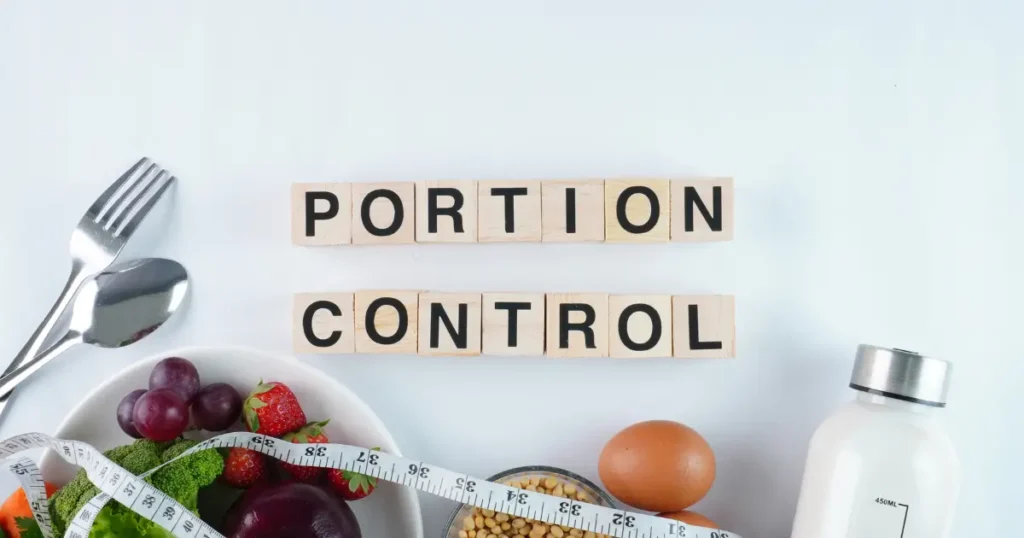
Proper portion size is a critical factor when determining what foods can dogs eat from the table. Even safe foods can cause problems when fed in excessive amounts.
Size-Appropriate Portions
You should modify portion proportions according to the size of your dog:
- Small dogs (under 20 lbs): No more than a teaspoon of most foods
- Medium dogs (20-50 lbs): No more than a tablespoon
- Large dogs (over 50 lbs): No more than 2-3 tablespoons
These are maximum amounts for occasional treats, not daily allowances.
Visual Guides for Portion Control
Some helpful visual comparisons:
- A piece of cheese should be no larger than your thumb tip
- A portion of meat should be smaller than a ping pong ball
- A serving of vegetables should fit in a bottle cap for small dogs
These visuals help prevent overfeeding table scraps to dogs.
The Palm Method
A simple technique for portion control:
- Place the potential treat in your palm
- If it occupies more than 10% of your palm’s surface area, it’s likely too large for a small dog
- Adjust proportionally for medium and large dogs
This method provides a quick visual check before sharing food with your pet.
Tip 12: Prepare and Store Food Safely
Food safety practices are just as important for your dog as they are for human family members. Safe preparation and storage are crucial aspects of determining what foods can dogs eat from the table.
Safe Food Preparation
Follow these guidelines when preparing food for your dog:
- Wash your hands before handling your dog’s food
- Use clean utensils and surfaces
- Cook meats to appropriate temperatures to kill harmful bacteria
- Wash fruits and vegetables thoroughly to remove pesticides
- Avoid cross-contamination between raw meat and other foods
These practices help prevent foodborne illness, an important consideration when sharing table scraps for dogs.
Proper Storage of Leftovers
If you’re saving human food for your dog:
- Refrigerate perishable items promptly
- Use within 2-3 days
- Freeze portions for longer storage
- Label and date stored foods
- Discard anything showing signs of spoilage
These storage practices are important for understanding what happens to a dog that eats table scraps that have been improperly stored—foodborne illness is a risk for dogs just as it is for humans.
Foods That Don’t Store Well
Some foods deteriorate quickly and should only be shared fresh:
- Avocado (once cut, it oxidizes quickly)
- Cooked vegetables (may ferment quickly)
- Dairy products (spoil rapidly at room temperature)
Being aware of these storage limitations helps you make informed decisions about what foods can dogs eat from the table safely.
The Pros and Cons of Feeding Dogs Human Food
When considering what foods can dogs eat from the table, it’s worth examining the broader pros and cons of feeding dogs human food to make an informed decision for your pet.
Potential Benefits
Thoughtfully shared table food may offer:
- Higher quality ingredients than some commercial treats
- Variety in texture and flavor
- Certain nutritional benefits when chosen carefully
- Reduced food waste in some cases
- Bonding opportunities during training
Potential Drawbacks
The downsides of sharing table food may include:
- Nutritional imbalance if overused
- Development of picky eating habits
- Encouraging begging behavior
- Accidental ingestion of harmful foods
- Weight gain if portions aren’t controlled
- Digestive upset from rich or unfamiliar foods
Finding Balance
The key is striking a balance that works for your dog:
- Maintain primarily commercial dog food for balanced nutrition
- Use table foods strategically as occasional high-value treats
- Be consistent with rules about when and what you share
- Educate all family members about safe and unsafe foods
This balanced approach minimizes the dangers of feeding dogs table scraps while allowing for occasional treats.
When to Seek Veterinary Help
Understanding what happens to a dog that eats table scraps that don’t agree with them is important for every pet owner. Knowing when to get aid from an expert can be lifesaving.
Emergency Situations
Seek immediate veterinary care if your dog consumes:
- Chocolate (especially dark or baking chocolate)
- Xylitol-containing products
- Grapes or raisins
- Significant amounts of onion or garlic
- Alcohol
- Large amounts of fatty foods
These can cause serious or life-threatening reactions.
Non-Emergency Concerns
Contact your veterinarian during normal hours if you notice:
- Persistent vomiting or diarrhea after eating table food
- Decreased appetite lasting more than 24 hours
- Lethargy or behavior changes
- Itching or skin issues after introducing new foods
These signs could point to a food intolerance that needs to be treated by a specialist.
Be Prepared
Have these resources available:
- Your veterinarian’s phone number
- Location of the nearest emergency vet clinic
- ASPCA Animal Poison Control: (888) 426-4435 (note: a consultation fee may apply)
- Pet Poison Helpline: (855) 764-7661 (note: a consultation fee may apply)
This preparation helps you respond quickly if problems arise when exploring what foods can dogs eat from the table.
Creating a Household Policy on Table Food
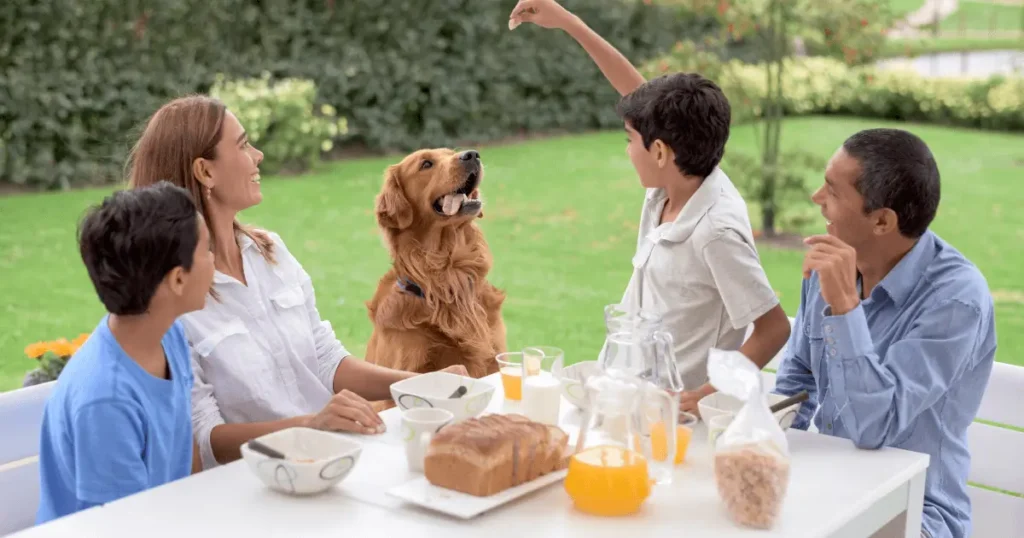
Establishing clear family rules about what foods can dogs eat from the table helps prevent accidental ingestion of harmful foods and maintains consistent training.
Sample Household Rules
Consider establishing guidelines like:
- No feeding from the table during meals
- All family members must check the approved foods list
- No food sharing without parental approval for households with children
- Keep a list of approved treats in an accessible location
- Designate specific “dog-safe” occasions for sharing
Clear rules help prevent problems that can arise from indiscriminate feeding of table scraps to dogs.
Communicating with Guests
Ensure visitors understand your policies:
- Inform guests about your rules before meals
- Explain why certain foods are dangerous
- Offer appropriate dog treats as alternatives for guests who want to bond with your pet
- Be especially vigilant during parties when food is more accessible
This communication helps protect your dog from well-meaning but potentially harmful food sharing.
Consistency is Key
Maintain consistent approaches to:
- Training around food behaviors
- Where dogs are allowed during human meals
- How treats are given (timing, circumstances, etc.)
This consistency helps minimize begging behaviors while still allowing for occasional appropriate treats.
Conclusion
Understanding what foods can dogs eat from the table requires balancing several factors: the inherent safety of the food, your individual dog’s health and tolerances, proper preparation methods, and appropriate portion sizes. The 12 tips we’ve explored provide a framework for making informed decisions about sharing human food with your canine companion.
While completely avoiding table scraps for dogs may be the simplest approach, many dog owners can safely share certain foods by following proper guidelines. The key is making educated choices rather than impulsive ones.
Remember that each dog is an individual with unique needs and sensitivities. What suits one dog might not suit another. Always observe your dog carefully when introducing new foods, and don’t hesitate to consult your veterinarian when questions arise.
By understanding both the dangers of feeding dogs table scraps and the potential benefits of thoughtfully selected human foods, you can make choices that support your dog’s health and happiness for years to come.
For more detailed information about specific foods mentioned in this guide, be sure to check our in-depth articles about whether dogs can eat popcorn, pickles, marshmallows, pretzels, Jello, and granola. These resources will help you make even more informed decisions about sharing specific human foods with your canine companion.
FAQs About Dogs and Table Food
Is it ever okay to feed my dog from the table?
While feeding directly from the table during meals isn’t recommended (as it encourages begging), there are safe human foods that can be given to your dog in appropriate settings, using proper portions, and with careful preparation. The key is understanding what foods can dogs eat from the table safely and setting boundaries around when and how these foods are offered.
What are the healthiest human foods I can share with my dog?
The healthiest options include plain cooked lean meats (chicken, turkey, lean beef), many plain cooked vegetables (carrots, green beans, pumpkin), and some fruits in moderation (blueberries, apple slices without seeds). These foods can provide valuable nutrients when properly prepared without added fats, sugars, or seasonings.
Will giving my dog table food make them a picky eater?
It can if not managed properly. Dogs may develop preferences for more flavorful human foods and become reluctant to eat their regular dog food. This illustrates one of the dangers of feeding dogs table scraps without a thoughtful approach. To prevent picky eating, keep human food sharing occasional and never use it to entice a dog who’s refusing their regular meals.
How can I tell if my dog has food allergies or sensitivities?
Signs may include recurrent skin problems (itching, redness, infections), gastrointestinal issues (vomiting, diarrhea), chronic ear infections, or excessive licking of paws. If you suspect food sensitivities, work with your veterinarian, who may recommend an elimination diet to identify trigger foods. This is an important aspect of understanding what happens to a dog that eats table scraps, as they’re sensitive to.
Is it safe to feed my dog leftovers?
Some leftovers may be safe if they only contain dog-friendly ingredients and are free from harmful seasonings, excessive fat, or other problematic components. However, many prepared human dishes contain multiple ingredients that may be problematic for dogs. Always thoroughly check leftovers against safe food rules before giving them to your pet.
